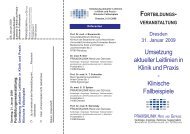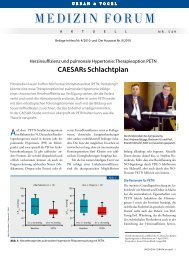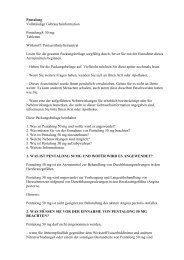HerzSupplement - Pentalong von Actavis
HerzSupplement - Pentalong von Actavis
HerzSupplement - Pentalong von Actavis
Erfolgreiche ePaper selbst erstellen
Machen Sie aus Ihren PDF Publikationen ein blätterbares Flipbook mit unserer einzigartigen Google optimierten e-Paper Software.
Der durch Fluoreszenzmessungen erkannte<br />
Einfluss der Substanzen auf die<br />
Amyloidaggregation wurde schließlich<br />
auch durch elektronenmikroskopische<br />
Aufnahmen mit Negativkontrastierung bestätigt,<br />
welche es ermöglichten, die Struktur<br />
und Form der gebildeten βAmyloid<br />
Fibrillen zu sehen. Hierbei wurde den Proben<br />
kein Fluoreszenzindikator zugesetzt.<br />
Auch hier wiesen Proben, die 90 Stunden<br />
mit dem Inhibitor LE-CL11 (Abb. 8 a, b, c)<br />
behandelt waren, eine im Vergleich zu unbehandelten<br />
Kontrollproben (Abb. 8 d, e,<br />
f) veränderte und stark reduzierte Aβ40<br />
Aggregation auf, was wiederum eine verminderte<br />
Plaquebildung in Aussicht stellt.<br />
Resümee<br />
Es ist gelungen, Statine chemisch so zu verändern,<br />
dass diese neuen Substanzen die<br />
Aggregation <strong>von</strong> amyloidogenem AßPolypeptid<br />
signifikant inhibieren. Vor allem<br />
resultierte aus der Nitratoacylierung zu<br />
einem SimvastatinNitratHybrid ein besonders<br />
potenter Inhibitor. Der Vergleich<br />
aller getesteten Substanzen lässt bisher keine<br />
deutliche StrukturWirkungsBeziehung<br />
erkennen. Auch bleibt bislang ungeklärt,<br />
ob und gegebenenfalls welchen Einfluss das<br />
organische Nitrat auf die Inhibition der<br />
direkten AßAggregation ausübt.<br />
Eine erste Antwort auf die Frage, ob die<br />
neuen Statinderivate auch klinisch erfolgreiche,<br />
neuartige AlzheimerTherapeutika<br />
sein können, soll nun durch InvivoUntersuchungen<br />
an transgenen Tieren gegeben<br />
werden. n<br />
Summary<br />
Statins are classically used in the treatment<br />
and prevention of hypercholesterolaemia<br />
due to their ability to reduce cholesterol<br />
synthesis. They act by blocking the HMG<br />
CoA reductase, which is the rate limiting<br />
enzyme in cholesterol synthesis. However,<br />
some studies have suggested the possible<br />
use of statins as potential therapeutics in<br />
the treatment of Alzheimer’s disease. Different<br />
pathways apart from their inhibitory<br />
activity on HMGCoA reductase have been<br />
explored. It has been shown that statins in<br />
Herz 35 · 2010 · Supplement II © Urban & Vogel<br />
fluence the release of βamyloid, which aggregates<br />
to senile plaques, a pathological<br />
hallmark of AD. Although the exact mechanism<br />
still remains unknown, this has been<br />
attributed to decreased cholesterol levels,<br />
as well as decreased isoprenoid biosynthesis,<br />
which directly influences APP processing.<br />
We have tested statin derivatives direct<br />
effect on amyloidaggregation as another<br />
possible pathway of their mode of action.<br />
Moreover we explored the possibility that<br />
modifying chemically the statins at their<br />
free lactonichydroxygroup could lead to<br />
compounds with inhibitory potency on direct<br />
Aβaggregation and hence prevent<br />
plaque formation. Surprisingly, results<br />
showed that a nitratoacylatedstatin derivative<br />
(LECL11) potently reduces amyloid<br />
aggregation down to 35% of untreated control.<br />
Keywords: statins – organic nitrates – statin<br />
nitrate hybride molecule – Alzheimer’s<br />
disease<br />
Literatur<br />
1. Jick H, Zornberg GL, Seshadri S, Drachman DA. Statins<br />
and the risk of dementia. The Lancet 2000;356:<br />
1627–31<br />
2. Parson RB, Farrant JK, Price GC, Subramaniam D,<br />
Austen BM. Regulation of the lipodation of β-secretase<br />
by statins. Biochem Soc Trans 2007;35(3):577–582<br />
3. Ostrowski SM, Wilkinson BJ, Golde TE, Landreth G.<br />
Statins reduce Amyloid-β production through inhibition<br />
of protein isoprenylation. J Biol Chem 2007;<br />
282(37):26832–44<br />
4. Gellermann G, Ullrich K, Tannert A, Unger C, Habicht<br />
G, Sauter S, Hortschansky P, Horn U, Möllmann U, Decker<br />
M, Lehmann J, Fändrich M. Alzheimer-like plaque<br />
formation by human macrophages is reduced by<br />
fibrillation inhibitors and lovastatin. J Mol Biol<br />
2006;360:251–257<br />
Für die Verfasser:<br />
Jochen Lehmann<br />
Pharmazeutisches Institut der Friedrich-Schiller-<br />
Universität Jena<br />
Lehrstuhl für Pharmazeutische/Medizinische<br />
Chemie<br />
Philosophenweg 12<br />
07747 Jena, Germany<br />
Tel.: +49 (0) 3641 949825<br />
Fax: +49 (0) 3641 949802<br />
E-Mail: j.lehmann@uni-jena.de<br />
Organische Nitrate<br />
17














